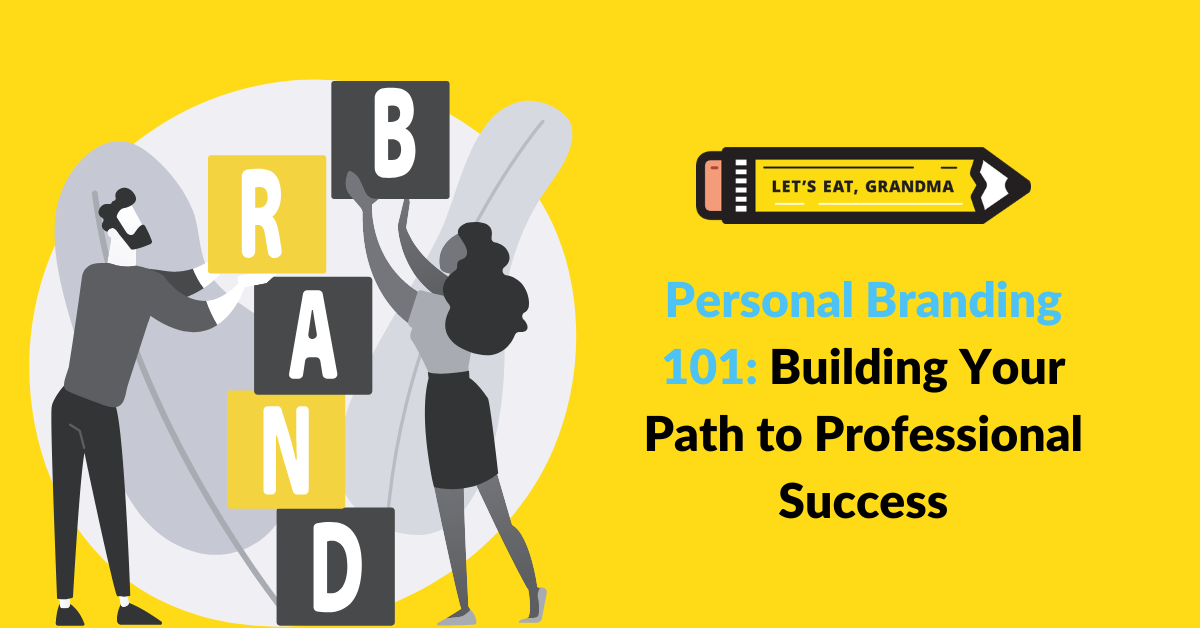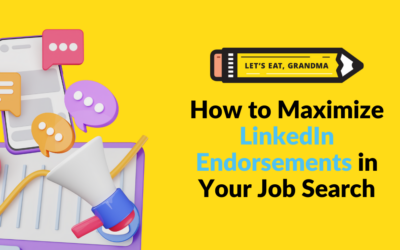Welcome to Let’s Eat, Grandma Personal Branding 101: Our top tips for advancing your personal brand on LinkedIn and in your professional portfolio
In today’s competitive job market, standing out is essential. Personal branding is a powerful tool that allows you to effectively market yourself and excel in your career.
The truth is you are a business, whether you own a business or not. After all, your goal is to effectively sell your value to prospective employers and industry professionals.
In this article, we will define personal branding, provide strategies to build a strong personal brand and explain how you can leverage it to benefit your professional life.
Understanding personal branding in your career
Personal branding is crafting and managing the image and reputation you want to project to the world. It involves defining your unique value proposition, highlighting your skills and expertise, and building a consistent and authentic online presence. Developing a strong personal brand allows you to stand out from the competition and leave a lasting impression.
What impression does your current resume leave on potential employers? Submit it for a free resume critique from one of our senior writers and gain valuable insights on enhancing your personal brand.
Optimizing your LinkedIn presence to strengthen your personal brand
In regard to personal branding, LinkedIn is the go-to platform for professionals. It is a virtual resume and a networking hub for connecting with industry peers and potential employers. The top strategies to optimize your LinkedIn profile include:
- Add a professional profile photo. Choose a well-lit, colored photo from your shoulders to just above your head. Use a solid or natural background, include a smile, and remove distractions. No groups, cats, or hats!
- Customize your LinkedIn cover photo. Instead of opting to use a generic banner or, worse, leaving it blank, utilize the prime real estate of your cover photo to showcase your unique brand. Consider custom-designed cover images or user-friendly templates from platforms like Canva.
- Craft a compelling headline. Develop a LinkedIn headline that immediately establishes your expertise and value. Use keywords relevant to your desired roles and add a brief professional value statement summarizing your impact.
- Showcase your work experience and accomplishments. Too often, people leave their work experience on LinkedIn blank, simply adding the roles they’ve held throughout their careers. To differentiate your personal brand, highlight measurable contributions, such as secured partnerships, increased sales, or optimized processes. Use impactful bullet points and include related media like publications, videos, and pictures to entice recruiters and make your work experience section more engaging.
- Secure endorsements and recommendations. Do you look at the reviews when deciding on a product to buy? Of course you do! You want to see if other people support the company’s claims of having the best product on the market. The same applies to the 77% of recruiters that use LinkedIn to find suitable applicants. They want to ensure that other professionals agree that you are indeed a skilled candidate. Stand out with endorsements and recommendations from managers, colleagues, and contacts. Encourage your first-degree connections to vouch for your expertise.
LEG Tip: Extend your social media presence to other professional documents. Add a customized LinkedIn URL to your resume, convert your LinkedIn headline into a professional value statement, and cite select recommendations from colleagues on your cover letter.
Building a strong network
Establishing and maintaining a strong network is crucial for personal branding success. LinkedIn offers several avenues to help you make connections to maximize your professional network. You can read our article on establishing LinkedIn connections for a deeper dive, but here are some key takeaways:
- Connect with industry professionals and colleagues, seeking informational interviews to learn from seasoned experts while positioning yourself as a viable candidate.
- Join industry-specific LinkedIn groups and engage in discussions to build relationships and establish expertise. Popular groups such as The Harvard Business Review and Marketing, PR, and Sales Innovators offer excellent networking opportunities.
- Attend LinkedIn networking events and conferences to meet new contacts and expand your network. Utilize search filters, check the Events homepage, or explore pages you follow for event recommendations.
- Follow industry leaders and influencers to stay updated on trends, learn from their experiences, and increase visibility. Engaging with their content enhances credibility and expands your network through their large followings.
LEG Tip: Demonstrate your strong network on your resume with a “Professional Affiliations” or “Public Speaking & Conferences” section. You can include community organizations you’ve participated in and workshops or seminars that you’ve led. In your cover letter, highlight how your network contributes to your expertise such as your ability to establish mutually beneficial partnerships and stay current with emerging trends.
Establishing thought leadership
Content creation and sharing is an effective way to establish thought leadership and demonstrate your expertise in your respective field.
Social media is usually the most accessible avenue for content creation. Here are some strategies for creating and sharing engaging content on social media sites like LinkedIn, Instagram, and Twitter:
- Share posts with industry insights and expertise to provide value to your network. Remember that tip about following industry leaders and influencers? Here’s another way it comes in handy. Simply resharing industry-relevant posts can strengthen your brand because by doing so, you add value to your network. You can also draw from your expertise to add original content.
- Publish articles and thought leadership pieces using LinkedIn’s publishing platform or start a blog and advertise the links on LinkedIn. While it may be daunting to promote your writing to the masses, knowing that you don’t have to be an established author or influencer to get in on the action may comfort you. Everyone from students to yoga instructors to commercial plant managers can share thoughtful articles on LinkedIn. You could write about your experience balancing academics and extracurricular activities as a student. A yoga instructor could write about ways they’ve adapted their yoga lessons for different demographics, i.e., children vs. pregnant women. A plant manager may write about strategies they’ve deployed to improve workplace safety. These are all simple ideas that incorporate personal experiences while providing valuable insights into your personal and professional journey and helping others navigate similar challenges. Consider that more published content = increased credibility and brand recognition.
- Engage with comments on your posts and others and drive conversations to establish yourself as an authority in your field. Writing comments on other people’s posts can promote discussions to their networks, expanding your reach to industry professionals and recruiters. To create engagement, scroll through LinkedIn until you find a post that interests you. Leave a comment that acknowledges the content creator while sharing your observations, interests, or answer to the question they posed. Then pose a question yourself so they or their network can respond.
Outside of social media, consider participating in industry discussions and forums, speaking at events, hosting webinars, and collaborating with influencers and thought leaders on projects.
LEG Tip: You can add a Publications section to your resume and LinkedIn where you can highlight your thought leadership expertise by including links to the industry-relevant articles you’ve written.
Showcasing your personal brand across your career assets
For your brand to be most recognizable and effective, it’s important to ensure it is consistent across all your career assets, including your resume, cover letter, and job interviews. Regularly review your portfolio to ensure that your brand messaging, values, and achievements are reflected in these materials. Tailor your resume and cover letter to highlight your unique selling points and use language that aligns with your personal brand. During job interviews, convey your personal brand through your communication style, demeanor, and examples of your work.
LEG Tip: Consider building a professional website that can serve as your online portfolio, especially if you are in the marketing or tech field. Add a link to this site on the featured section of your LinkedIn and on the headings of your resume and cover letter. Also, be sure to mention it during your interviews to further impress the hiring managers.
Managing and monitoring your personal brand
Personal branding is a continuous process that requires regular management and monitoring. Review the following tips on how to effectively maintain your personal brand:
- Conduct regular audits of your LinkedIn profile, resume, and other platforms to ensure they accurately represent your current skills and achievements.
- Update your LinkedIn profile and resume with new accomplishments and experiences as they occur. We recommend creating and maintaining a “Brag Book” that includes all your achievements in real time. You can use a notepad, a folder on your laptop, or even the notes app on your phone to document every time you secure a sale, get nominated for an award, host a workshop, or receive a client’s kudos. This way you won’t have to worry about forgetting your measurable accomplishments when updating your resume!
- Monitor and promptly respond to LinkedIn messages and connection requests to maintain strong relationships and demonstrate professionalism.
Looking ahead
Building a strong personal brand is an essential step toward professional success. By understanding the concept of personal branding, optimizing your social media presence, building a strong network, creating engaging content, showcasing your brand across career assets, and managing your personal brand effectively, you can enhance your visibility, credibility, and opportunities in the job market. Start building your personal brand today and unlock the potential for growth and success in your career.
Remember, if you need assistance with your resume or want to receive a critique, seek help from one of our experienced resume writers who can provide valuable insights.
Ready to get started? Submit your resume for a free critique so our professional resume writers can help you further refine your personal brand.
Related Links:
How to Maximize Your LinkedIn Endorsements in Your Job Search




